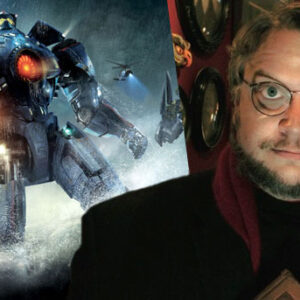Last Updated on August 2, 2021

PLOT: Legions of alien creatures from another dimension known as Kaiju invade our world, destroying many of our major cities. Only man-made robots called Jaegers have the power to combat them.
REVIEW: You can’t accuse Guillermo del Toro of not wearing his 14-year-old self on his sleeve. The filmmaker, perhaps more than any other working today, represents the fanboy-who-made-it; a big-time director in his 40s who still acts and dreams like the little kid who played with Star Wars toys all day, watched scary movies all night and went to the movie theater whenever he got a chance. The man makes the movies he wants to make, without an ounce of cynicism or greed infused in the work; that little kid wonder always present, even in the darker stuff like PAN’S LABYRINTH.

And PACIFIC RIM is the ultimate projection of a little kid’s brain on a movie screen. It’s a movie about giant robots fighting giant monsters (well, inter-dimensional aliens, actually, but whatever) and it features such prolonged, breathless bouts of carnage that it’s like del Toro is standing there above it all, crashing his toys together in the backyard and ignoring his parents’ demands that he grow up. It’s a testament to del Toro’s spirit that he was able to take $200 million of someone else’s money in order to realize the ultimate nerd daydream, which basically is “holy shit wouldn’t it be cool if aliens were fighting giant robots for like one hour straight?!?!”
But not unlike an eager adolescent, del Toro is primarily concerned with the superficial holy shit-ness of the idea (dreamt up by co-writer Travis Beacham). PACIFIC RIM offers enjoyable spectacle when it’s going crazy knocking its toys together, but there’s such a glaring lack of depth or intrigue to the rest of it that I can’t help but be frustrated. Look, I’m not naive; I know PACIFIC RIM is all about the money shots, and if I want three-dimensional characters and a thoughtful story I can go see a Almodovar film; but did the human drama have to be so severely lazy? Some will say, “Well, it’s made for kids!”, but I’ve always been a firm believer in the idea that just because it’s made for the young – and the young-at-heart – doesn’t mean it can’t also contain complexity. (Isn’t that the charge we always level at the STAR WARS prequels whenever Lucas tells us they were meant for children?)
The story is well-known to most likely everyone right now. At some point, for some reason, a fissure appeared at the bottom of the ocean and monsters from another dimension came through to wreak havoc. And they keep coming, devastating several cities for years until all of humanity’s resources are pooled into a defense system known as Jaegars, walking, fighting robots who engage the Kaiju in battle. The Jaegers are nifty, but also quite complicated, and they need two pilots to work in tandem to control them; this is accomplished by something called “The Drift”, which melds the minds of the pilots and basically enables them to know each others thoughts and memories. (It’s one of the movie’s best and most original ideas.) The attacks are clearly getting worse, and with the Jaegers taking some harsh beatings recently, the government is threatening to shut down the program and move toward building giant walls meant to block out the raving creatures.

The film’s first act is more or less a necessary preamble to the good stuff. Weirdly, del Toro zooms through the set-up in the first few minutes; he doesn’t want to waste time on the initial Kaiju attacks or exposition, he wants to get right to the part where we already have giant robots in place. It definitely feels rushed, but the impulse is understandable. Our main character is Raleigh Beckett (Charlie Hunnam), once a Jaeger pilot, now a construction worker despondent over the death of his brother. Of course, Raleigh will need to get back into action with the Jaeger program’s imminent closure, and he’s brought out of retirement by his former commander, the stern Stacker Pentecost (Idris Elba).
Raleigh is paired with a woman named Mako (Rinko Kikuchi). Shy but superbly intelligent, Mako has long wanted to be a pilot but has been held back by Stacker, a father-figure, because of his fear that her emotions will get the best of her in the heat of battle. (You basically have to shut out your memories while you’re piloting a Jaeger; tough for her to do when her mind is enveloped by thoughts of her city being leveled by Kaiju when she was a young girl.) Raleigh and Mako form a platonic bond that makes them an ideal fit, but they’ll have to prove to themselves and to Stacker that they can actually handle being sent into the field.
There are archetypes, and then there are cardboard cut-outs, and del Toro and Beacham deliver the latter. Every character’s motivation, backstory and goal has been etched in stone for as long as we can remember, and no one deviates from the script. Raleigh carries the memory of his brother around like a sack and has to overcome his doubts about himself. Mako too is saddled with her own bad memories, as well as a severe need to convince her father figure, Stacker, that she’s a worthy pilot. Stacker, for his part, is rough and gruff, but of course has a soft heart for the misfits who want to impress him. Surprising, that these rather commonplace characters have been developed by del Toro, who is usually adept at infusing genuine humanity into his protagonists.

That said, Elba and Kikuchi are extremely charismatic and well-cast, with faces the camera loves (Kikuchi in particular is completely lovable). Hunnam, however, is a complete cipher, neither exuding the charm nor the depth that would have made his character something more than a dull handsome hero. In fact, Hunnam is so detrimental to the film that all energy seems to ooze out of the picture when he’s engaged in a dramatic scene. It’s not that he’s a bad actor; he’s just lacking in the fundamental magnetism that a leading man requires. (To be fair, it’s not his fault that he’s saddled with dialogue like this: “I spent so much time thinking about the past, I forgot about the future. Until now.”)
Del Toro’s supporting characters mostly function as groan-worthy comic relief. Charlie Day and Burn Gorman flail about wildly as scientists who are trying to predict the Kaiju’s next moves, but their presence is mostly a nuisance; a bickering-couple routine that is frankly tiresome. Del Toro often has no trouble conjuring up entertaining, light-hearted moments in his films; the HELLBOY movies contain plenty of amusing bits and sight gags that appeal to all ages. But here the attempt to inject schtick-y comedy into the proceedings is unwelcome. (To be fair, the two actors completely fulfill their obligations to the roles with manic overacting.)
So what about those massive battles? Well, del Toro takes his time getting to the kick-off, but once it begins, it rarely ends; the whole second half of the film is one big demolition derby. (Not unlike the argument leveled against Superman’s wanton destruction at the end of MAN OF STEEL, it seems worth noting that the Jaegers often commit as much building-busting mayhem as the monsters they are fighting.) What’s somewhat disappointing about these sequences, however, is the way they’re shot: almost all of the good stuff takes place at night, in the rain, so sometimes it’s a little difficult (literally) to really enjoy the circus. Del Toro is a good action director; he’s not obsessed with cutting every two seconds, generally holding on the conflict long enough for us to get an idea of the geography and physicality of the fights. But it’s just so dark that I yearned for the skies to clear so we could fully take it all in. Add to that, there’s a climactic action scene that takes place underwater, which is cool in theory, but not necessarily in practice; the visuals in this case are also murky and grim. (The 3D does not help with this.)

But I’m not here just to be a negative Nelly: Credit must go to ILM for their remarkable CGI; when their work is allowed to be fully revealed, it’s wonderful to behold. (Like the images inside the gigantic “Shatterdome”, the location where the Jaegers are kept and repaired; there’s a whole world within this place.) There are many fantastic details in both machine and monster; del Toro is well-known for his ability to fill every frame with interesting visual information, and he doesn’t disappoint with PACIFIC RIM. The director also successfully peaks our interest in the Kaiju, giving them keen animalistic behavior, from the way they surround their opponents to the way they thrash and convulse when they’re being defeated. There are some really cool ideas hinted at with these monsters, and if a sequel does indeed come about, I’d like to spend some time just with them to see what they’re like when they’re not being thrown across the ocean.
And yes, there’s just something about seeing a robot use a ship to beat down a creature that brings a smile to my face. The Jaeger and the Kaiju tumbling about in Hong Kong is easily my favorite scene.
I don’t flat-out dislike PACIFIC RIM, just as I don’t blame del Toro for tossing his vivid dreams onto the screen every chance he gets. The movie is more or less brainless, but not soulless, and if the little kid inside of you is able to ignore the stiffness of the human characters and the predictability of the story, you’ll probably be more than happy to play in del Toro’s backyard. I just wanted a little flesh-and-blood.




















Follow the JOBLO MOVIE NETWORK
Follow us on YOUTUBE
Follow ARROW IN THE HEAD
Follow AITH on YOUTUBE